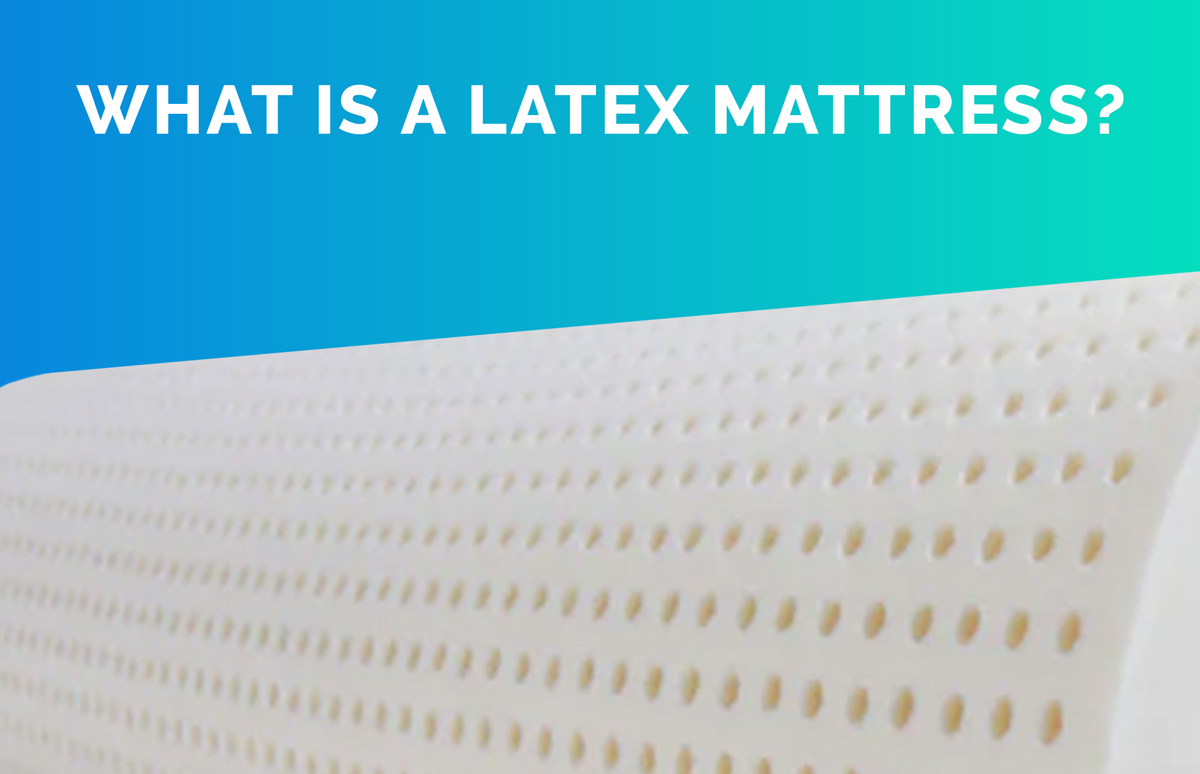
If you’ve been looking around for a new bed, you probably have come across some latex mattress options. Latex mattresses have been growing increasingly popular in the last few years and are offered alongside more traditional options such as innerspring and memory foam mattresses online and in stores. Built with either natural or synthetic latex layers, latex beds are naturally hypoallergenic, cooling, responsive, and durable. Is a latex bed right for you? Just keep reading — we’ll give you all the details and lay out the pros and cons so you can decide if a latex bed is the best mattress for your unique sleep needs.
What Is a Latex Mattress?
Latex foam was reportedly invented in the 1920s and was used to make couch cushions, motorcycle seats, and mattresses. Latex beds took off in popularity as a mattress option that didn’t go flat or need to be fluffed like the standard down mattresses of the time. After memory foam beds came onto the market in the 1990s, they replaced latex beds as the most popular foam mattress because they are easier and more expensive to produce. More recently, however, consumers have found that the latex bed’s durability and hypoallergenic features make it a worthwhile investment.
Natural latex is made by taking the liquid sap of the rubber tree and whipping it into foam. Foam made in this way is naturally chemical-free, eco-friendly, and durable. Latex mattresses can also be built with synthetic latex, made from petrochemicals and fillers like polyurethane, or a blend of natural and synthetic mattresses.
Latex Types
- Dunlop: Dunlop latex is usually made from 100 percent natural rubber tree liquid that is poured to fill the mold all at once. Because it is made without fillers and the process consists of one single pour, Dunlop latex can settle inconsistently and result in foam that is softer on top and firmer at the bottom.
- Talalay: Talalay latex is made with natural latex that is poured into the mold in stages. After each pour, the mold is vacuumed so the latex fits the form uniformly, then the latex layer is frozen and reheated to create a consistent texture throughout the mold. Although this type of latex is considered more advanced, the process requires the use of artificial fillers — so Talalay latex can never be 100 percent natural or organic.
- Synthetic: Synthetic latex is made with petrochemicals that are processed to mimic the feel of natural latex layers. Synthetic latex may not bother those with latex allergies, but it is not as durable as natural latex.
- Blended latex: When natural latex and synthetic latex are combined, you have blended latex. Blended latex is less expensive than natural latex, but it has a lower chemical content than synthetic latex. Talalay latex is an example of blended latex.
Latex Mattress Firmness
Latex mattresses come in a wide range of firmness levels, from softer beds to mattresses with a firm feel. The best mattress firmness level for you depends on your body type, sleeping position, and personal preferences. Those with lightweight body types typically prefer a softer mattress so they can sink into the bed’s comfort layers, while heavier sleepers usually need a firmer bed to provide them with adequate support.
When it comes to sleeping position, side sleepers tend to be most comfortable on a softer mattress, and stomach sleepers generally want a firmer bed to keep their midsection supported. Back sleepers often prefer a bed that falls somewhere in the middle with a medium-firm feel.
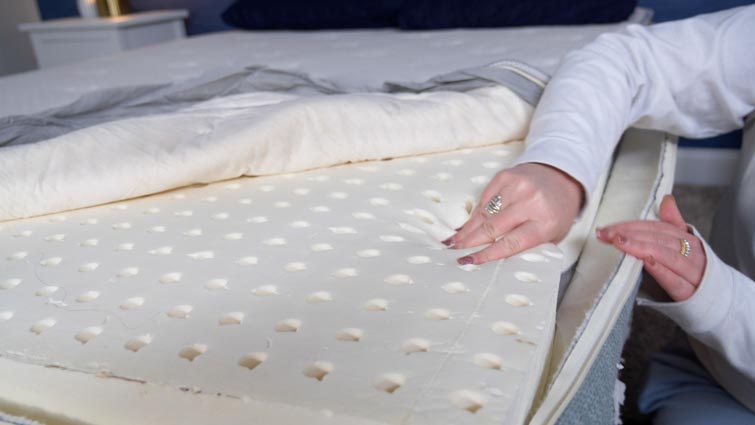
Benefits of a Latex Mattress
There are many pros of latex mattresses, like them being responsive to your movements, eco-friendly, hypoallergenic, durable, breathable, temperature regulating, and pressure-relieving. Let’s go over these benefits in more detail below.
Responsive
Latex quickly adjusts to support you as you change sleeping positions. This means you can move around easily on the mattress and won’t feel stuck in the indentations made by your body if you are a combination sleeper or tend to toss and turn.
Eco-Friendly
Natural latex is a sustainable and biodegradable mattress material — we can source latex from the rubber tree without chopping it down. Latex foam can also be made without unpleasant and potentially harmful chemicals, such as formaldehyde and perfluorocarbons.
Hypoallergenic
Natural latex rebels mold, dust mites, and other common allergens — but keep in mind synthetic latex doesn’t have the same features.
Durable
Latex foam is denser than other types of mattress foam. While this makes a latex mattress heavier, it also makes it more durable. A latex bed can last up to 20 years, compared to the average seven to 10 year lifespan of an innerspring or memory foam bed.
Cooling
If you sleep hot or live in a warmer climate, latex could help you stay cool throughout the night. Latex is naturally aerated thanks to the air bubbles that are trapped in the layers as the rubber sap is made into foam. This added breathability helps body heat move away from the bed so the surface of the mattress stays cool to the touch.
Pressure-Relieving
Latex gently gives underneath your joints and pressure points that press into the surface of the bed. This feature helps relieve pressure from these areas of the body to prevent aches and pains when you wake up in the morning. Although latex beds don’t provide the same deep pressure relief as soft memory foam beds, they have enough give to help keep the average sleeper comfortable.
Cons of Latex Mattresses
There are also some downsides associated with latex mattresses, like them typically being more expensive than many other mattress types, having a unique feel that’s not for everyone, and sometimes providing high motion transfer. Some sleepers also have latex allergies. Let’s discuss these cons further below.
Price
Latex mattresses have great features — but these can come with a higher price tag. Latex is considered to be one of the more expensive mattress types. Many mattress brands and retailers offer payment plans and seasonal sales, but there are more affordable options if you are on a tight budget. The Avocado Eco Organic is one of the more affordable latex mattresses on the market. You can also consider adding a latex mattress topper to your bed in order to get the latex feel at a lower cost. Check out our roundup of the best cheap mattresses for some great budget-friendly mattress choices.
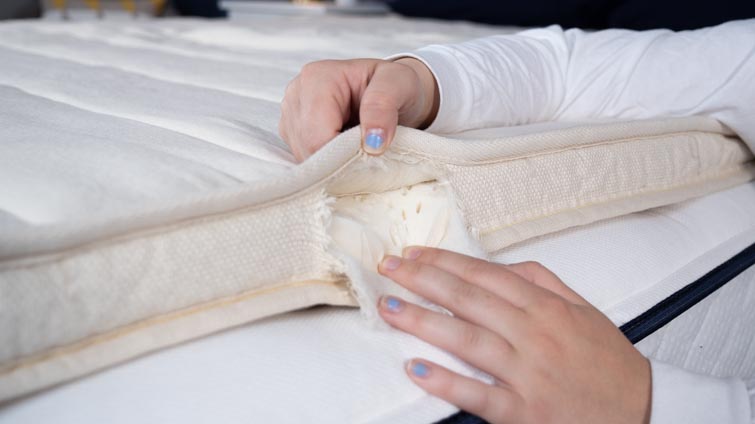
Feel
Latex mattresses have a unique feel that may not appeal to those who grew up sleeping on memory foam or innerspring mattresses. Latex has a buoyant, bouncy feel that may not provide enough pressure relief for those who prefer the deep hug of memory foam layers or the sturdy feel of an innerspring mattress.
Latex Allergies
Studies show around 1 percent of the general population has a latex allergy. However, latex allergy reactions are reported up to 12 times more often with health care professionals since they’re regularly exposed to the material. If you are allergic to latex, you could try a synthetic latex bed or try wrapping your mattress in a mattress cover to avoid exposure to the bed’s latex layers — but if your symptoms are severe, it may be safest just to steer clear of this mattress type altogether.
Motion Transfer
Latex can be known to transfer motion. If you sleep with a partner or a pet, you may feel their movements on your side of the bed if your mattress doesn’t limit motion transfer. Latex beds can carry the vibrations of your partner’s movements to your side of the bed, which could disturb your rest if you are a light sleeper.
Latex vs Memory Foam
Latex and memory foam are two of the most popular mattress types available. Here’s what you need to know about each.
Similarities
- Pressure relief: Both of these types of beds will gently hug your body as you sleep to relieve pressure from your joints.
- Variety of firmness options: You can find latex and memory foam mattresses in a wide range of firmness levels, from plush and soft to very firm.
- Availability: You can find both memory foam and latex mattress models in both brick-and-mortar showrooms and from online retailers, so you can shop however you like.
Differences
- Feel: Latex has a bouncy, responsive feel that gives the sensation of floating on top of the mattress as you lay on it. This also typically gives latex a firmer feel than memory foam. Memory foam allows your body to sink gently into the bed, which can provide a plush, hugging sensation as you sleep.
- Heat retention: Memory foam can tend to trap heat, while latex foam is built with air pockets that allow hot air to escape from the mattress.
- Durability: Latex layers are denser than memory foam, so latex beds tend to hold up over time. A latex mattress could last up to a decade longer than a memory foam model.
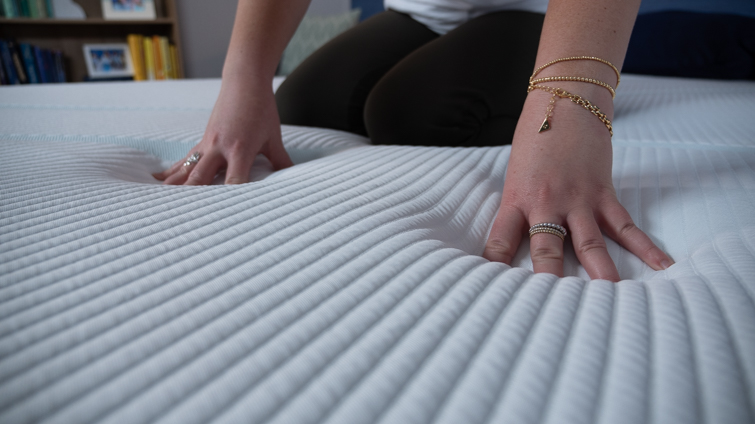
Other Mattress Types
There are also a few other types of mattresses you may be familiar with: innerspring mattresses and hybrid mattresses.
Innerspring Mattresses
Many of us grew up sleeping on innerspring mattresses. These beds are typically built with a thick layer of metal coils sandwiched between two thin layers of encasement foam. Innerspring mattresses are available at a wide range of prices, from extremely budget-friendly options to luxury models. Innerspring mattresses are breathable, bouncy, and responsive, but they don’t offer much pressure relief compared to other mattress types.
Hybrid Mattresses
Hybrid mattresses are made with two or more different mattress materials, so you can enjoy the benefits of multiple mattress types in a single bed. Many hybrid mattresses are made with latex layers. Latex is combined with innerspring coils to add extra responsiveness and pressure relief while keeping the bed cool. Latex and memory foam hybrid beds are also popular, since they combine the temperature regulation and durability of latex with the deep cushioning of memory foam.
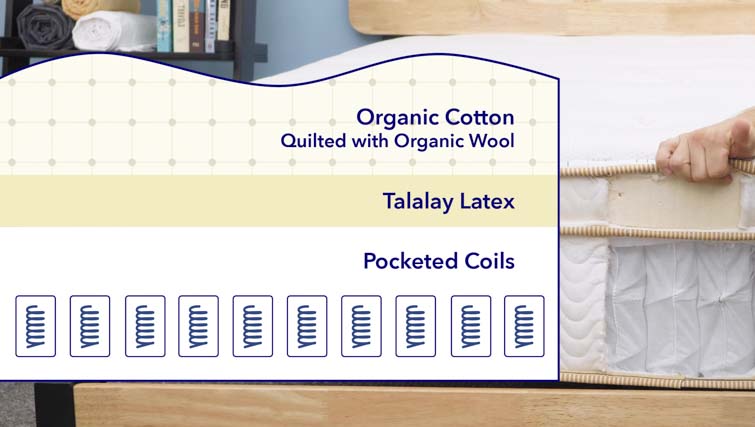
Latex Mattress Cost
Latex is a more expensive mattress material because it is higher quality and more time consuming to produce than other mattress types. Many mattress brands that use natural or organic latex also will pay to ensure that their products meet rigorous standards such as Global Organic Latex or Textile Standards.
Latex Mattress Lifespan
Thanks to the dense, durable nature of latex foam, your latex mattress can last up to 15 years before it needs to be replaced. Mattresses made of Dunlop latex tend to last longer than Talalay, but either type of latex bed is a great investment for decades of comfortable sleep.
FAQs
Is latex good for mattresses?
Latex is a durable, responsive, and pressure-relieving mattress material. It can provide sturdy support to all body types while providing a balance of pushback and comfort to help your back stay in a natural posture throughout the night. While the unique feel of latex may not be the best fit for everyone, there are many different latex mattresses you can choose from to suit your unique sleep needs.
How is synthetic latex different from natural latex?
Synthetic latex is created from petrochemicals. It can be less expensive and more durable than natural latex, but is not eco-friendly or hypoallergenic.
Can you flip a latex mattress?
It is not recommended to flip many latex mattresses. Many mattresses are designed with comfort layers closer to the top of the mattress and firm support layers close to the bottom. If you flip your mattress, you may be uncomfortable since you won’t be able to benefit from the top soft layers. Check with your mattress manufacturer before you flip your bed. If you’re trying to prolong your mattress’ life, we recommend rotating it 180 degrees a few times a year.
How long does a natural latex mattress last?
Latex beds are some of the most durable mattresses on the market and can last 10 to 15 years before you have to replace them.
Is a latex bed good for your back?
Latex provides a firm level of support that is balanced with gentle pressure relief. The mix of these two features makes latex beds good picks to support most sleepers. However — if you are a lightweight sleeper, rest on your side, or need extra pressure relief, you may want to consider a plush memory foam mattress.
Do latex mattresses sag?
Any mattress will start to sag over time — your body weight will wear down your bed over time. Latex, however, is one of the most durable mattress types on the market and also are typically backed up with generous warranties to protect your investment.
Does a latex mattress get softer over time?
All beds go through an initial break-in period when you first purchase them and will often feel softer afterwards. Most mattresses will have a sleep trial period where you can try your new mattress in your own home to see if you like it and want to keep it. Your bed will be broken in after about a month or two of sleeping on it.
Conclusion
Latex mattresses are some of the most durable and eco-friendly beds on the market. If you’re looking for a cooling, supportive bed that is also good for the environment, a latex one could be just what you’re looking for. Even though they can also be one of the pricier options out there, there are some great options in our best latex mattress roundup to help you find the best latex bed for your sleep preferences and budget.



























